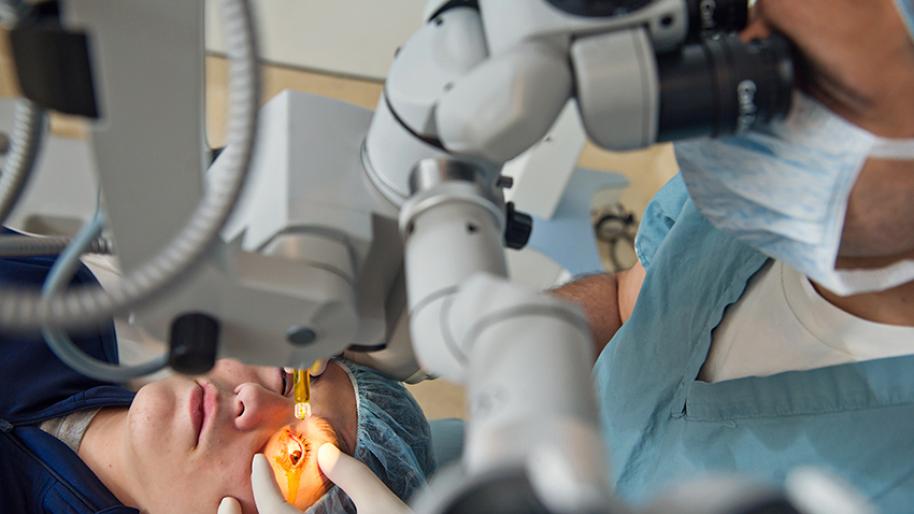Corneal cross linking is a procedure used to strengthen corneas. The Kellogg Eye Center is proud to offer this innovative treatment.
Corneal cross linking is a minimally invasive procedure that uses ultraviolet light and eye drops in order to strengthen the collagen fibers in the cornea. The procedure is used for patients with keratoconus, a condition in which the cornea grows thin and weak.
During a corneal cross linking procedure, your doctor will first apply riboflavin (vitamin B2) eye drops, and then shine a specific type of ultraviolet light directly onto your cornea. The eye drops consist of a substance conducive to photo enhancing, which enables cross linking to take place. The procedure causes new corneal collagen cross-links to develop. Those cross links cause the collagen fibrils to shorten and thicken, leading to a stiffer, stronger cornea.
Corneal cross linking is an outpatient procedure that typically lasts for about an hour.
Symptoms/Conditions
A healthy cornea resembles a clear, round dome. Located at the front of your eye, your cornea is what helps you to see, by focusing the light that enters through your eye.
In people with keratoconus, however, the cornea doesn’t have enough collagen fiber cross-links, which serve as a kind of structural support. Without those cross-links, the cornea begins to bulge out in a cone-like shape. That bulge results in blurred, distorted vision as the cornea weakens and thins. The condition, which can significantly impair vision, is difficult to treat with glasses. Severe cases of keratoconus may even require corneal transplant.
Symptoms of keratoconus typically include blurred or distorted vision and increased sensitivity to light.
Risks
As with any other surgical procedure, there are risks involved with corneal cross linking.
Because corneal cross linking includes the removal of the corneal epithelium (the thin layer on the cornea’s surface), risks may include epithelial haze or scarring, corneal epithelial defect (disruption of surface cells) or delayed epithelial healing.
Other risks may include infection of the cornea by bacteria or viruses, corneal opacity, decreased vision, blurred vision, scarring, and corneal striae (the appearance of fine white lines in your field of vision). Severe ulceration or severe inflammation of the eye are other more rare side effects.
Corneal cross linking is associated with a low rate of risks and complications. For more information, talk with your Kellogg provider about the possibility of side effects.
Surgical Options
Corneal cross linking is currently the only effective treatment to prevent progression of keratoconus.
What to Expect
- You’ll be awake during the procedure, which will take about an hour.
- You’ll be given a mild sedation and numbing anesthetic drops will be applied to your eyes.
- Patients typically do not experience significant discomfort during the procedure.
- After the procedure, you may experience increased sensitivity to light, as well as general discomfort in the affected eye. Some patients describe that discomfort as a gritty, burning sensation. If you experience more severe pain, contact your doctor immediately.
- Avoid rubbing your eyes for up to five days following the procedure.
Make an Appointment
University of Michigan Kellogg Eye Center is among the most experienced ophthalmology programs in the nation to offer corneal cross-linking.
Kellogg began offering cross-linking to patients during national clinical trials to examine the procedure’s safety and effectiveness. Results of the trial led the U.S. Food and Drug Administration to approve cross-linking as a new treatment for progressive keratoconus in mid-April 2016.
For more information about corneal cross-linking or to schedule an appointment, call the Refractive Surgery clinic at the Kellogg Eye Center in Ann Arbor at 734-615-8441.
Reviewed by Angela Verkade, MD

